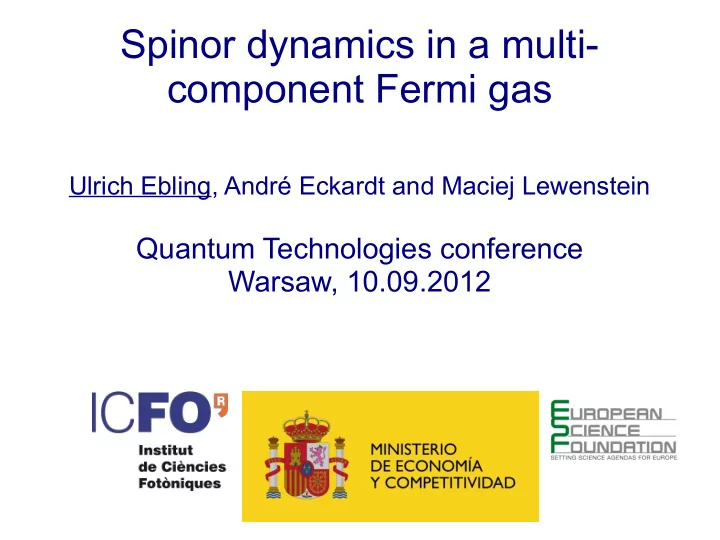

Spinor dynamics in a multi- component Fermi gas Ulrich Ebling, André Eckardt and Maciej Lewenstein Quantum Technologies conference Warsaw, 10.09.2012
Spinor dynamics in a multi- component Fermi gas Outline ● Description by density matrix / Wigner function ● Collisionless regime (mean field) ● Spinor dynamics ● Collisional approach (extension to mean field) ● More spinor dynamics ● Conclusions and outlook
Spinor gases Overview and motivation Spinor gas: Spin F , 2 F +1 internal states ..., m = -3/2, m = -1/2, m = 1/2, m = 3/2, … ... Collisions preserve total spin → more than 2 components lead to spinor dynamics m + n = m' + n' n m' Internal states after the collision can be different than before. Spinor dynamics = population transfer m n' Quadratic Zeeman effect → Zeeman energy not conserved
Trapped spinor fermi system Hamiltonian and density matrix Single particle: Two particle: S-wave-scattering, weak interactions: We describe the system and its time evolution with the single-particle-density-matrix
Wigner function Definition: Advantages: Knowing W we can extract many observables by integration / tracing Suited for collisional methods 1) In phase-space: Thomas-Fermi distribution, exact for non-interacting gas. 2) In spin space: Lots of freedom to create spin states. Examples: Mixed state (incoherent): Pure state (coherent):
Equation of motion Von Neumann-equation: Wick decomposition (mean field or Hartree-Fock approximation) Exchange interaction Mean field → effective Potential Quantum Liouville equation: Semiclassical approximation for coordinates (not spin!): Spin-mean-field (leading order) mean-field correction to trap
Coherent spinor dynamcis Coherent population transfer, described by mean-field theory. Has been also observed in spinor BEC. Parameters: Initial coherences, scattering lengths, number of states, QZE,... Many possibilities. Here: F =9/2, initial state coherent superposition of m =±9/2, ±7/2, ±5/2 Oscillatory modes Magnetic field Frequency ~ QZE
Coherent spinor dynamcis Coherent population transfer, described by mean-field theory. Here: F = 5/2, initial state m = ±3/2, small seed in m = ±1/2 Exponential modes m = ±1/ 2 t x Feature: Formation of spatial structures: Interplay of orbital and spin degrees of freedom m = ±5/2 does not participate, can create lower spin subsystem
Spin waves Collective excitations arising from exchange interaction. Spatial movement of spin components. Described by mean-field approach. Dipole oscillations for F=3/2 Coherent states are very susceptible to magnetic field gradient Gradient displaces spin components in the trap Problem: Spatial separation reduces spinor dynamics Spin waves easy to excite, hard to get rid of Gradient present Outlook: Interesting to study for higher spins due to presence of higher magnetic multipoles.
More spinor dynamics Is a mean-field approach good enough? For a mixed initial state, mean-field predicts no spinor dynamics. Coherence (off-diagonal elements) needed. Vanishes for incoherent states Experimental data, trapped 40K, F = 9/2 incoherent spin mixture m = ±1/ 2 Mean field theory predicts: Courtesy of Sengstock group
Collisional approach Is a mean-field approach good enough? Equation is a collisionless Boltzmann equation Experimental data, trapped 40K Hydrodynamic regime ? Collisionless (Knudsen) regime gn Are we still here? Looks like relaxation to equilibrium Superfluid
Collisional approach Correction to mean-field approach Boltzmann equation: J. N. Fuchs, D. M. Gangardt and F. Laloë, Eur. Phys. J. D 25, 57 (2003) R.h.s: “Collisional Integral”, change of density-matrix due to collisions Many approaches possible, we choose the Lhuillier-Laloë – Ansatz (not the only one!) Change of the single-particle density matrix Δ t small, but still longer than duration of collisions A collision is a two-particle process, we know what happens to the two-particle density matrix (Heisenberg S-matrix) L.-L.: No entanglement before and after the collision - Boltzmann's molecular chaos (Stosszahlansatz) Why? Many-particle system. No repeated collisions between same particles Two-particle situation, F =9/2: Krauser et al. ArXiv 1203.0948 (2012)
Collisional approach Collision integral S-matrix to T-matrix: Wigner transform everything, get terms linear and quadratic in T: Expand T-matrix in powers of the scattering lengths: First order reproduces the mean-field equation of motion Second order, beyond mean-field, includes momentum transfer Quadratic Zeeman-shift
Collisional dynamics Relaxation induced by collisions. Long time scales Comparison with experimental data Incoherent process. Damps spin waves, coherent dynamics Particles exchange momentum, restore system to equilibrium Standard approach: Relaxation time approximation High spin system may be too complicated m', -k' -m, -k Momentum distribution, relaxation to equilibrium blocked: pre-thermalization? m, k -m k' Δ QZE Collision in presence of QZE: m 2 > m ' 2 , k ' > k
Conclusions We have derived a multi-component Boltzmann-equation that combines Mean field effects ● Coherent spinor dynamics ● Spin waves ● Collision effects ● Relaxation ● Damping of coherent phenomena ● Thermalization ● in a trapped multi-component Fermi gas for a wide range of parameters Spin F , magnetic field, temperature, initial coherences, scattering lengths,... ● and with good agreement with experiments.
Recommend
More recommend